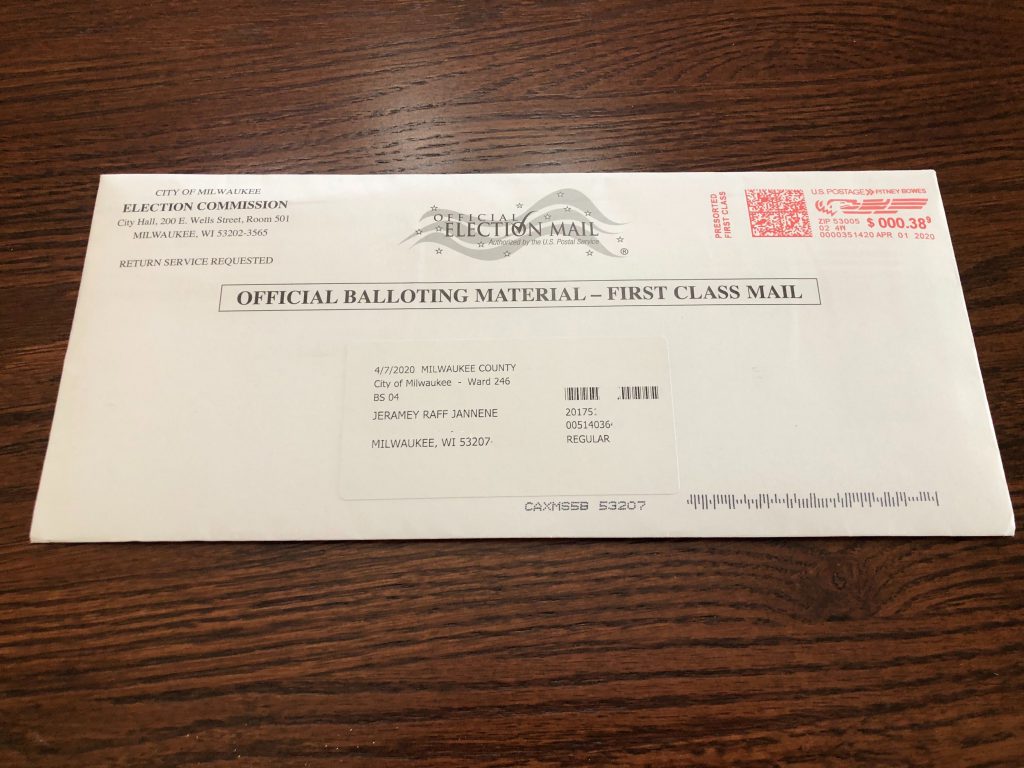City Accepts Ballots Without Clear Postmarks
390 of 11,141 ballots received after election day had missing or illegible post marks.
The Milwaukee Election Commission voted Monday to accept absentee ballots received by mail without a postmark or with an illegible postmark. The move allows 390 ballots to be counted, 3.5 percent of the 11,141 ballots received by the city after election day.
State law requires that absentee ballots must arrive back at the issuing municipality by 8:00 p.m. on election day. But federal judge William Conley extended that window six days to April 13th as a result of the COVID-19 pandemic and higher than normal absentee ballot volumes and mail delays. Then, with less than 24 hours before the polls opened, the Supreme Court of the United States overruled Conley and said the ballots can arrive by April 13th, but must be postmarked by April 7th.
But the United States Postal Service (USPS) doesn’t postmark all mail. The practice is used to cancel stamps, but most ballots across the state were mailed with metered mail systems that use an ink mark. Milwaukee uses an indicia (prepaid ink marking) on its mail that isn’t regularly canceled.
The problem was greatly minimized because many voters, after the U.S. Supreme Court decision, asked for a postmark and because a directive sent by the USPS instructed employees to mark ballots with a postmark.
“I don’t see it as simply just having to interpret what the US Supreme Court said. I think my role here as a commissioner is to make sure we have fair and transparent elections,” said Commissioner Carmen Cabrera.
But Commissioner Jess Ripp, a former Republican state senate candidate, saw the issue differently. “I feel very bookended by the Supreme Court’s decision,” said Ripp. “Unfortunately, there does seem to be room for a compromise, but the court and the Legislature have failed… it’s tragic, I don’t see a way around it.”
Commission Chair Stephanie Findley agreed with Cabrera and the three-member commission voted to accept ballots received without a postmark from April 8th through April 13th. “I think that stands a stronger case if it’s challenged in the court of law,” said Findley of the decision to vote separately on whether to allow each day’s ballots rather than in just one vote for all 390 ballots.
A report from Milwaukee Election Commission Neil Albrecht shows that the percentage of ballots received each day with valid postmarks decreased daily. On April 8th, the day after the election, 100 percent of the 6,029 ballots with readable postmarks were marked April 7th or earlier. A total of 199 ballots had illegible or missing postmarks that day. By April 13th that number had fallen to 5 percent (15 ballots) with valid postmarks from April 7th or before. Thirty-six ballots had no postmark or an illegible postmark, but all will be counted.
Two representatives of USPS attempted to provide guidance on post office processes and procedures, but could not issue definitive guidance on many cases. That includes whether ballots could be received by a municipality the same day they were mailed, an issue of particular interest for ballots received April 8th. “It could be possible, however highly unlikely,” said marketing manager Stan Franke.
“They were unsworn statements from the postal service and from an evidentiary point of view I didn’t find them very helpful,” said deputy city attorney Adam Stephens after the commission had spent an hour on the matter.
“How do we conclude exactly what happened? We can’t,” said Cabrera. “It is possible that these ballots were mailed by April 7th, we don’t know. And through no fault of the voter, we don’t know.”
While 390 ballots will now be counted, 1,377 returned ballots will not be counted. Those include ballots postmarked too late or with a missing witness signature.
Municipalities will begin to report their results at 4 p.m. on Monday afternoon.
The matter was first scheduled to be heard yesterday, but that meeting had to be canceled after it was hijacked by anonymous Zoom users sharing pornographic and lurid content.
If you think stories like this are important, become a member of Urban Milwaukee and help support real, independent journalism. Plus you get some cool added benefits.
More about the 2020 Spring Primary
- Why Don Natzke Couldn’t Vote - Enjoyiana Nururdin - Aug 9th, 2020
- Centers for Disease Control and Prevention’s Morbidity and Mortality Weekly Report highlights public health measures taken by the Milwaukee Health and Fire Departments, Department of Administration, Election Commission, and the Wisconsin Department of Health Services - City of Milwaukee Health Department - Aug 4th, 2020
- CDC Says Election Did Not Cause COVID-19 Spike - Erik Gunn - Aug 4th, 2020
- Pandemic Reduced Black Vote, Study Finds - Dee J. Hall - Jun 25th, 2020
- Did April Election Hike COVID-19 Cases? - Alana Watson - May 20th, 2020
- Elections Commission Notes ‘Lessons Learned’ - Henry Redman - May 19th, 2020
- Wisconsin Elections News: WEC Releases Analysis of Absentee Voting in April 7 Spring Election - Wisconsin Elections Commission - May 18th, 2020
- Election’s Impact on County’s COVID-19 Cases Unclear - Jeramey Jannene - May 6th, 2020
- Why State’s Voting By Mail Was Chaotic - Daniel C. Vock - May 4th, 2020
- At Least 40 COVID-19 Cases Tied to Election in Milwaukee - Graham Kilmer - Apr 24th, 2020
Read more about 2020 Spring Primary here






















